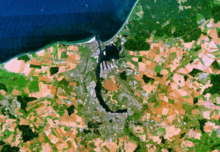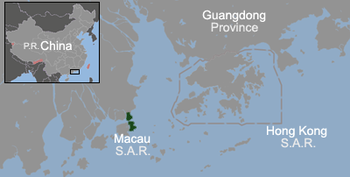Estuary
An estuary ( Latin aestuarium “estuary exposed to the flood” or “bay”) is the broad body of water at the mouth of a river or stream on a mostly shallow depression coast .
According to the Leeuwarden Declaration the landward boundaries of estuaries in the German Bight defined as the average limit of brackish water to fresh water and the seaward limits than the average position of 10 PSU - isohaline .
At tidal coasts one finds typical funnel-shaped estuaries like the lower Elbe . But also the estuary lagoons, which can be found on depression coasts without a strong tidal range, are called estuaries, for example the Unterwarnow . An elevation coastal / or and large boulder freight prevail against it deltas before, even with strong tides as the Ganges - Brahmaputra -Delta. Tidal deltas can consist of estuaries, such as the Amazon delta and the part of the Rhine-Maas-Scheldt delta in the Dutch province of Zeeland . In the EU Water Framework Directive , in addition to rivers , still waters and coastal waters for estuaries, the additional category of transitional waters was created. The application is still under development.
Recently, the term estuary has also been applied to those estuaries that do not meet all the definition requirements: the Ems estuary is not funnel-shaped, the Unter- Warnow and Unter- Trave are not tide-dependent, and the inner and outer jades are strict because of their high salinity not taken the lower reaches of the Jade River .
Origin and characteristics
Funnel-shaped estuaries

Typical estuaries are under the influence of tidal formed streams, wherein the flow orifice is funnel-shaped ( funnel mouth ): In these tidenbeeinflussten transition zones between marine and fluvial areas of the tide effect a pendulum motion of often larger volume than the seaward discharge flow of the river water. The high flow velocities associated with the pendulum movement ensure that the erosion is stronger than the sedimentation . At high tide, the heavy salt water penetrates into the river in a wedge shape from the sea and is covered by the river's fresh water. The river bed and the banks are eroded by the strong flood current, and a lot of material is transported upstream.
This material cannot be transported away again due to the usually weaker ebb current. For this reason, delta formation can occur at the upper end of estuaries. A remnant of such a delta is the branching off of the Elbe in Norderelbe and Süderelbe in Hamburg. Maritime shipping has been using estuaries as natural harbors for centuries. Here the ships lay protected from storms and pirates. Before the motorization, the vehicles were driven by the tidal current to the port cities, mostly founded at the inner end of the funnel, which, located in the middle of the country, had a large catchment area. Although not quite as confusing as deltas, estuars also mostly require pilots.
Due to the Coriolis force , the sea water is deflected clockwise in the northern hemisphere and counterclockwise in the southern hemisphere. Depending on the geographical conditions, the river banks can be affected differently by erosion and sedimentation.
In the Amazon one can detect the flood current up to approx. 870 km from the coast.
| Eider | Elbe | Weser | Ems | |
|---|---|---|---|---|
| Catchment area above the weir [10³ · km²] | 2 | 135 | 38 | 13 |
| Average water flow rate [m³ / s] | 23 | 725 | 323 | 125 |
| Mean tidal range in the weir area [m] | 2 | 2.4 | 4.1 | 2.8 |
| Length of the inner estuary [km] (without funnel-shaped mouth area) |
21st | 120 | 70 | 50 |
Lagoon-like estuaries
On coasts with no significant tidal range, the flow acceleration due to the tides is missing. So there is no defining characteristic “exposed to the flood”. Here, the slowing of the current dominates at river mouths. Dunes on the coast create an additional flow barrier. On uplift coasts, sedimentation in the storage area leads to rapid silting up and thus to delta formation. On submerged coasts, especially in rivers with low bed load, the sedimentation is offset by the continuous rise in sea level. This creates microtidal estuaries , not funnel-shaped, but lagoon-shaped like the Unterwarnow and the Stettiner Haff at the mouth of the Oder . Bays created during the Ice Age can also become estuaries, such as the Traveförde at the mouth of the Trave.
Water quality
Estuaries, like deltas, are characterized by the transition from fresh water to salt water ( brackish water ), a material transport caused by water movements. This depends on the flow velocity of the fresh water flowing off the river in relation to the tide and the amount of salt water flowing up with it. The tide, in turn, depends on the position of the moon (see spring tide , nipp tide ) and the respective weather conditions (possible storm surge ) and thus results in a very individual change in the animal and plant world from the river area to the sea due to the average water temperature.
Rivers with estuaries
Mouth funnel
America
- Amazon - its northern mouth combined with a forming underwater delta
- Hudson
- Río de la Plata - common estuary of Paraná and Uruguay
- Saint Lawrence River
Africa
Asia
- Yenisei
- If
- Pearl River - common estuary of the west , east and north rivers
Australia
The southeastern Australian state of New South Wales has more than 170 estuaries along more than eleven hundred kilometers of coastline: Since 2006, the state has measured the water temperature comprehensively in 1 m water depth. It shows that brackish water warms up faster than average in the wake of man-made global warming : by almost 2.2 ° in less than 12 years.
Europe
Estuary lagoon
Transitional forms
See also
- Inland delta
- Liman ( lagoon-like estuaries on the Black Sea )
- Mangrove (ecosystem)
- Muzzle arm
- Ria
swell
- Karl-Franz Busch (Ed.): Water (= BI-Taschenlexikon ). 2nd revised edition. VEB Bibliographisches Institut, Leipzig 1988, ISBN 3-323-00202-4 .
Web links
- Bulletin 86 ( Memento from October 10, 2007 in the Internet Archive ): various articles on the "Description and analysis of the estuary dynamics in sea waterways" and "Mathematical modeling as an indispensable basis for advice"
- http://www.baw.de/downloads/publik/mitteilungsblaetter/mitteilungsblatt86/weilbeer.pdf (link not available)
Individual evidence
- ↑ a b c B. Schuchardt, M. Schirmer, G. Janssen, S. Nehring, H. Leuchs: Estuaries and brackish waters. ( Memento from January 31, 2012 in the Internet Archive ) In: F. De Jong, JF Bakker, CJM van Berkel, NMJA Dankers, K. Dahl, C. Gätje, H. Marencic, P. Potel: Wadden Sea Quality Status Report. Wadden Sea Ecosystem No. 9. Common Wadden Sea Secretariat, Trilateral Monitoring and Assessment Group, Quality Status Report Group. Wilhelmshaven 1999. (PDF; 342 kB).
- ↑ Frank Ahnert: Introduction to Geomorphology. 4th edition. Ulmer, 2009, ISBN 978-3-8001-2907-2 , 17.2.7 Ästuardelta.
- ↑ Andreas Malcherek: Tides and waves. The hydromechanics of coastal waters. Vieweg + Teubner, Wiesbaden 2010, p. 81.
- ↑ Unterwarnow as an estuary. (PDF; 574 kB) (No longer available online.) Vzb.baw.de, archived from the original on October 23, 2013 ; Retrieved April 3, 2013 .
- ↑ http://www.lung.mv-regierung.de/daten/gewsymp_11_schernewski.pdf (link not available)
- ↑ Climate change in Australia - estuaries on the east coast are warming particularly quickly. Accessed January 12, 2020 (German).


